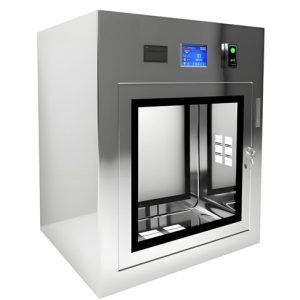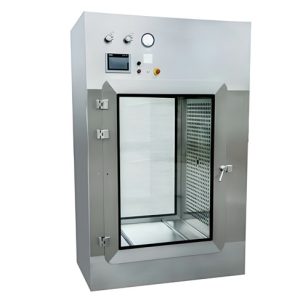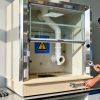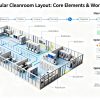Account
-
Safe payment options
We only work with the most secure payment systems.
-
Product return within 30 days
We do our very best to keep our customers happy.
No products in the cart.
You dont have any products in your cart yet, add a few products to experience this experience.
Add $500.00 to cart and get free shipping!
To see and take advantage of all discounted products.
Click HereModular Cleanroom Accessories — Types, Specs & Buying Guide
Modular cleanroom accessories are critical components that ensure the functionality, compliance, and performance of controlled environments across pharmaceutical, semiconductor, biomedical, and aerospace industries. Proper selection and integration of these accessories directly impact cleanroom classification, operational efficiency, and regulatory compliance.
Author: Dr. Michael Chen, Cleanroom Engineering Specialist | Published: October 15, 2023 | Last Updated: March 22, 2024
Certified Cleanroom Professional (CCP) with 15+ years experience in pharmaceutical and semiconductor cleanroom design.
Table of Contents
ToggleOverview
This comprehensive guide covers all essential modular cleanroom accessories, from pass-through windows and HEPA/ULPA filtration systems to ESD control equipment and monitoring devices. We provide detailed technical specifications, selection criteria, and practical guidance based on international standards and industry best practices.
Key Benefits of Proper Accessory Selection:
- Maintain ISO Class 1-9 cleanroom standards
- Ensure regulatory compliance (FDA, EU GMP, SEMI)
- Reduce contamination risks and product loss
- Optimize energy efficiency and operational costs
- Extend equipment lifespan through proper integration
Modular Cleanroom Accessories Overview
Pass-through Windows / Transfer Hatches
Maintain pressure integrity while transferring materials between different clean zones. Available in stainless steel, powder-coated steel, or polycarbonate with interlock systems.
HEPA/ULPA Fan Filter Units (FFU) & Prefilters
Provide laminar airflow with efficiency up to 99.999% on 0.3μm particles. Integrated motor-blower assemblies with variable speed control for precise airflow management.
Doors & Seals
Hermetic sliding, swing, and airlock doors with EPDM or silicone gaskets. Critical for maintaining pressure differentials and contamination control between zones.
Wall/Ceiling Panels, Trim & Coving
Modular panel systems with coved corners for easy cleaning. Materials include powder-coated steel, stainless steel, and GRP with various finish options.
Lighting, Fixtures & Penetrations
Cleanroom-rated LED lighting with sealed housings. Power and data penetrations maintain room integrity while providing necessary utilities.
Shelving, Carts & ESD Control
Stainless steel or powder-coated shelving, mobile carts, anti-static mats, and grounding systems for ESD-sensitive environments.
Monitoring & Control Systems
Differential pressure gauges, particle counters, temperature/humidity sensors, and Building Management System (BMS) integration for real-time monitoring.
Technical Specifications & Selection Criteria
| Parameter | Specification Range | Selection Criteria |
|---|---|---|
| Material Compatibility | Stainless steel 304/316, powder-coated steel, aluminum, polycarbonate, acrylic | Chemical resistance, cleanability, structural requirements |
| Surface Finish | Ra ≤ 0.5μm (electropolished), 0.4-0.8μm (mechanical polish) | Particle shedding, cleanability, corrosion resistance |
| Outgassing (TML/CVCM) | TML ≤ 1.0%, CVCM ≤ 0.1% (per ASTM E595) | Vacuum/space applications, sensitive processes |
| Fire Rating | Class A (non-combustible) to Class C | Building codes, insurance requirements, safety standards |
| ESD Performance | Surface resistance 10^6-10^9 Ω (IEC 61340-5-1) | Electronics manufacturing, sensitive equipment protection |
| HEPA Efficiency | 99.97%-99.9995% on 0.3μm (EN 1822: H13-H14) | Cleanroom classification, process requirements |
| IP Rating | IP54 to IP66 (dust and water resistance) | Wash-down areas, humid environments |
Material Selection Guide
Stainless Steel 316L: Optimal for pharmaceutical and biotech applications requiring frequent chemical sterilization.
Powder-Coated Steel: Cost-effective for electronics manufacturing with good cleanability.
Polycarbonate: Ideal for pass-through windows and viewing panels where impact resistance is important.
Standards & Compliance
Compliance with international standards is essential for cleanroom certification and operational approval. Below are key standards applicable to modular cleanroom accessories:
ISO 14644 Series
Cleanrooms and associated controlled environments – Classification, testing, monitoring, and design requirements.
EN 1822
High efficiency air filters (EPA, HEPA, ULPA) – Classification, testing, and marking.
ASHRAE 170
Ventilation of health care facilities – Air change rates and filtration requirements.
IEC 61340
Electrostatics – ESD control requirements for electronics manufacturing.
NFPA Standards
Fire protection and life safety requirements for cleanroom facilities.
USP <800></800>
Hazardous drugs – Handling in healthcare settings, including ventilation requirements.
Critical Inspection Points by Accessory Type:
HEPA/ULPA Filters: Integrity testing, efficiency certification, frame construction
Doors & Windows: Airtightness test, gasket integrity, interlock functionality
Wall/Ceiling Systems: Panel flatness, joint tightness, coving radius
ESD Control: Surface resistance, grounding continuity, charge decay
Buying Guide & Compatibility Checklist
Selecting the right modular cleanroom accessories requires careful consideration of your specific application, cleanroom classification, and operational requirements. Use this guide to ensure compatibility and optimal performance.
Cleanroom Classification Matching
| ISO Class | Recommended Accessory Specifications | Critical Considerations |
|---|---|---|
| ISO 1-3 | ULPA filters (U15-U17), electropolished SS, minimal joints | Maximum contamination control, minimal outgassing |
| ISO 4-5 | HEPA H13-H14, seamless coving, airtight doors | Pharmaceutical manufacturing, microelectronics |
| ISO 6-7 | HEPA H13, powder-coated panels, standard doors | Medical device manufacturing, compounding pharmacies |
| ISO 8-9 | HEPA H13, basic panels, cost-effective solutions | Food processing, packaging, less critical applications |
Procurement Checklist
Technical Requirements
- Material compatibility with cleaning agents
- Surface finish and cleanability
- Outgassing specifications (TML/CVCM)
- ESD control requirements
- Fire rating compliance
Supplier Evaluation
- Request product samples for evaluation
- Verify certifications and test reports
- Review Factory Acceptance Test (FAT) protocols
- Confirm Minimum Order Quantity (MOQ)
- Evaluate warranty terms and support
Compatibility & Integration
- Dimensional compatibility with existing systems
- BIM/CAD file availability for planning
- Installation clearances and access requirements
- Interface with monitoring/control systems
- Future expansion considerations
Installation & Maintenance Best Practices
Proper installation and maintenance of modular cleanroom accessories are crucial for achieving and maintaining cleanroom performance specifications. Please follow these guidelines to ensure long-term reliability and compliance.
Installation Steps
- Pre-installation Inspection: Verify all components, check for damage
- Sealing & Penetrations: Proper gasket installation, sealant application
- Component Assembly: Follow manufacturer sequence and torque specifications
- Integration: Connect to utilities, control systems
- Verification: Confirm proper operation, alignment
Acceptance Testing
- HEPA Leak Test: Scan filter media and frame with aerosol photometer
- Pressure Hold Test: Verify room integrity at specified pressure differential
- Airflow Velocity & Uniformity: Measure at multiple points across filter face
- Particle Count: Verify cleanroom classification per ISO 14644-1
- ESD Testing: Verify surface resistance and grounding continuity
Maintenance Schedule
- Daily: Visual inspection, surface cleaning
- Weekly: Gasket inspection, ESD testing
- Monthly: Pressure differential verification
- Quarterly: Filter pressure drop monitoring
- Annually: Full recertification testing
Modular cleanroom accessories Common Installation Issues & Solutions:
Poor Sealing: Ensure gaskets are properly compressed (typically 25-30% compression)
Air Leakage: Conduct smoke testing to identify and seal leakage paths
ESD Failure: Verify proper grounding and use megohmmeter for resistance testing
Filter Damage: Handle with care during installation; use protective covers
Modular cleanroom accessories replacement Cost Estimation
Plan for periodic replacement of consumable components. Typical lifespans:
| Component | Typical Lifespan | Replacement Cost Factor |
|---|---|---|
| HEPA/ULPA Filters | 5-10 years | 20-30% of initial cost |
| Gaskets & Seals | 3-7 years | 5-10% of component cost |
| ESD Flooring/Mats | 2-5 years | 15-25% of initial cost |
| Lighting | 5-8 years | 10-20% of initial cost |
Frequently Asked Questions
FFU airflow selection depends on your cleanroom classification, room dimensions, and internal heat loads. General guidelines:
- ISO Class 5: 0.45-0.5 m/s face velocity (90-100 fpm)
- ISO Class 6: 0.35-0.45 m/s face velocity (70-90 fpm)
- ISO Class 7: 0.25-0.35 m/s face velocity (50-70 fpm)
Calculate required airflow using: Airflow (m³/h) = Room Volume (m³) × Air Changes Per Hour. Consult ISO 14644-4 for specific requirements.
Pass-through window seal testing should be performed during commissioning and periodically thereafter:
- Close and latch the pass-through door
- Apply soap solution to all gasket surfaces
- Pressurize the interior to 25-50 Pa above ambient
- Observe for bubble formation indicating leaks
- Alternatively, use smoke pencil to detect airflow
Acceptance criteria: No visible bubbles or smoke penetration with 25 Pa pressure differential maintained for 5 minutes.
ESD mat grounding must comply with IEC 61340-5-1 standards:
- Surface resistance: 10^6 to 10^9 ohms
- Point-to-point resistance: 10^6 to 10^9 ohms
- Grounding connection resistance: < 1 ohm
- Use dedicated ESD ground points, not electrical grounds
- Test monthly with calibrated surface resistance meter
Ensure continuous grounding through snap connectors and 1M ohm resistors for personnel safety.
HEPA filter replacement depends on several factors:
- Pressure Drop: Replace when pressure drop increases 50% above initial clean value
- Time: Typically 5-10 years with proper prefiltration
- Environmental Factors: More frequent in high particulate or chemical environments
- Performance: Immediately if integrity testing fails
Monitor differential pressure monthly and conduct annual integrity testing per IEST-RP-CC034.
TML (Total Mass Loss) and CVCM (Collected Volatile Condensable Materials) are both measured in ASTM E595 outgassing tests:
- TML: Total percentage of mass lost when heated to 125°C for 24 hours in vacuum
- CVCM: Percentage of outgassed materials that condense on a collector at 25°C
- Acceptance Criteria: Typically TML ≤ 1.0% and CVCM ≤ 0.1% for cleanroom applications
CVCM is more critical as these condensable materials can deposit on sensitive surfaces.
Resources & Next Steps
Modular cleanroom accessories Download Technical Resources
Request Samples or Quote
References & Standards
International Standards
- ISO 14644-1:2015 – Classification of air cleanliness
- ISO 14644-2:2015 – Monitoring for compliance
- ISO 14644-3:2019 – Test methods
- ISO 14644-4:2022 – Design, construction and start-up
- ISO 14644-5:2021 – Operations
- ISO 14644-7:2022 – Separative devices
- ISO 14644-8:2022 – Classification of air cleanliness by chemical concentration
- EN 1822-1:2019 – HEPA and ULPA filters
- IEC 61340-5-1:2016 – ESD protection
Industry Guidelines & Testing
- ASTM E595-15 – Modular cleanroom Standard Test Method for Total Mass Loss and Collected Volatile Condensable Materials
- IEST-RP-CC001.4 – HEPA and ULPA Filters
- IEST-RP-CC006.3 – Testing Cleanrooms
- IEST-RP-CC018.4 – Cleanroom Housekeeping
- IEST-RP-CC034.2 – HEPA and ULPA Filter Leak Tests
- NFPA 45 – Standard on Fire Protection for Laboratories
- ASHRAE 170-2021 – Ventilation of Health Care Facilities
- USP General Chapter <800> – Hazardous Drugs</800>










